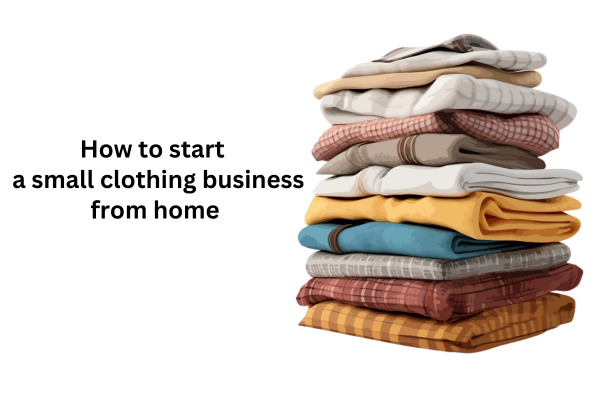
Introduction
If you are interested in fashion design then start a small clothing business from home. Today everyone wants to wear new design clothes. The clothing business is in great demand in the market because people will never stop wearing and buying clothes. If you are also an expert in fashion design then you can also be successful in this business. So let’s know in detail in this article how to take your small clothing business forward.
Why Start a Small Clothing Business from Home?
Flexibility and Low Overhead
Starting a small clothing business from home can be flexible.Starting a clothing business from home has many advantages. You can work from home as per your convenience. And the overhead of a home-based business is much lower than renting a physical store.
Creative Control
Market Research
Find Your Niche
Before you start producing, you need to find your niche. Casual wear, formal wear, activewear, eco-friendly fashion? Whatever it is, finding a specific target market will help you design and market your brand.
Research the Competition
Look at other clothing brands that cater to your niche. What do they do well and where are the gaps in the market? This will give you an idea of how you can differentiate your business and attract customers.
Business Plan
Set Goals
Financials
Make sure to manage your money. Work out how much you’ll need to start, like materials, equipment, and marketing. Then make a budget to control your spend and make sure you make a profit.
Home Workspace
Set up your home office or workshop
Even though you’re working from home, you’ll need a dedicated space to run your business. Set up a home office or small workshop where you can design, produce and manage your business without interruptions.
Essential Tools and Equipment
You’ll need basic tools like a sewing machine, fabric, pattern-making supplies, and a computer to manage your online store. Invest in good quality equipment so your products look professional.
Sourcing
Finding Suppliers
To make good clothes you need to source from good suppliers. Research different suppliers and compare prices but don’t sacrifice quality to save money. Building relationships with suppliers can also get you better deals in the long run.
Sustainable Sourcing
If you want to be an eco brand consider sourcing sustainable materials like organic cotton, recycled fabrics, or plant-based dyes. This will appeal to the growing number of consumers who care about ethical fashion.
Designing Your Collection
Designing Unique Pieces
Your designs are the core of your clothing business. Focus on designing pieces that reflect your brand and your target market. Sketch out your ideas, test fabrics and refine your designs until they’re ready to go into production.
Being On Trend
While it’s important to stay true to your vision, being on trend can help you design unique and relevant pieces. Keep up with fashion blogs, magazines, and social media influencers.
The Legals
Registering
Before you launch your collection make sure you register your business with the relevant authorities. This will give you legal protection and you can operate as a legitimate business.
Tax and Legal
As a business owner, you’ll need to keep on top of your tax obligations. Research the tax laws in your area and consider hiring an accountant to help you manage your finances and make sure you’re compliant.
Branding
Building a Brand
Your brand is more than a logo; it’s the feeling your business gives to customers. Think about the values, look, and message you want your brand to convey. This will shape your logo, website,e, and marketing materials.
Logo and Branding
A professional logo and consistent branding are key to credibility and attracting customers. Consider hiring a graphic designer to design a logo for your brand.
Building an Online Presence
Website
In this digital age having an online store is crucial. Use platforms like Shopify, Wix, or WordPress to set up a user-friendly website where customers can browse and buy your clothes.
Social Media
Social media is a powerful tool to promote your clothing business. Platforms like Instagram, Pinterest, and TikTok work well for fashion brands. Use them to show your designs, engage with your audience,e and drive traffic to your website.
Pricing Your Products
Working Out Costs and Profit
You need to get the price of your clothes right. You need to factor in the cost of materials, labor, shipping, and other expenses to make a profit. Don’t forget to include discounts or sales.
Competitive Pricing
While you need to cover your costs you also need to be competitive. Research similar brands in your niche to make sure your pricing is in line with industry standards and reflects the quality of your products.
Marketing Your Clothing Business
Influencer Marketing
Working with influencers can be a great way to get your clothing line in front of more people. Reach out to influencers in your niche who fit your brand values and aesthetic.
Running Online Ads
Consider running paid ads on Facebook and Instagram to reach customers. These ads can be targeted to demographics, interests, and shopping behavior to get the right people.
Inventory and Shipping
Stock
Shipping for Home-Based Businesses
As a home-based business, you’ll need to find cost-effective shipping solutions. Consider partnering with shipping services that offer discounts for small businesses or look into fulfillment options if you want to outsource shipping.
Customer Service
Great Customer Support
Good customer service is the key to keeping customers loyal. Be responsive to queries, resolve issues quickly, and always aim to exceed customer expectations.
Returns and Complaints
Returns and complaints will happen in any business. Have a clear return policy in place and handle complaints professionally and nicely to keep your brand reputation positive.
Conclusion
Starting a small clothing business from home is tough but rewarding. With the right planning, creativity, and dedication you can build a fashion brand that speaks to your target market. Research, develop your brand,d and market your products and you’ll be on your way to turning your passion for fashion into a business.
FAQs
The startup costs can vary, but you can begin with as little as $500 to $2,000 depending on materials, equipment, and marketing needs.
Yes, registering your business provides legal protection and allows you to operate officially, even if you’re starting on a small scale.
Popular platforms include Shopify, Etsy, and even social media like Instagram. Choose a platform that aligns with your audience and business needs.
Focus on finding a unique niche, providing high-quality products, and creating strong branding that resonates with your target audience.
While not mandatory, offering sustainable options can help attract a growing audience of eco-conscious consumers who prioritize ethical fashion.





